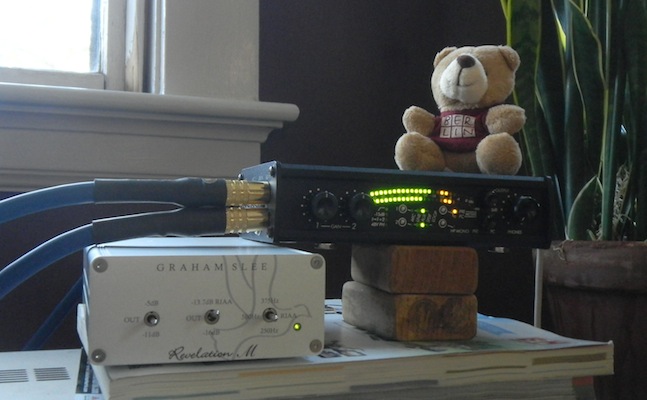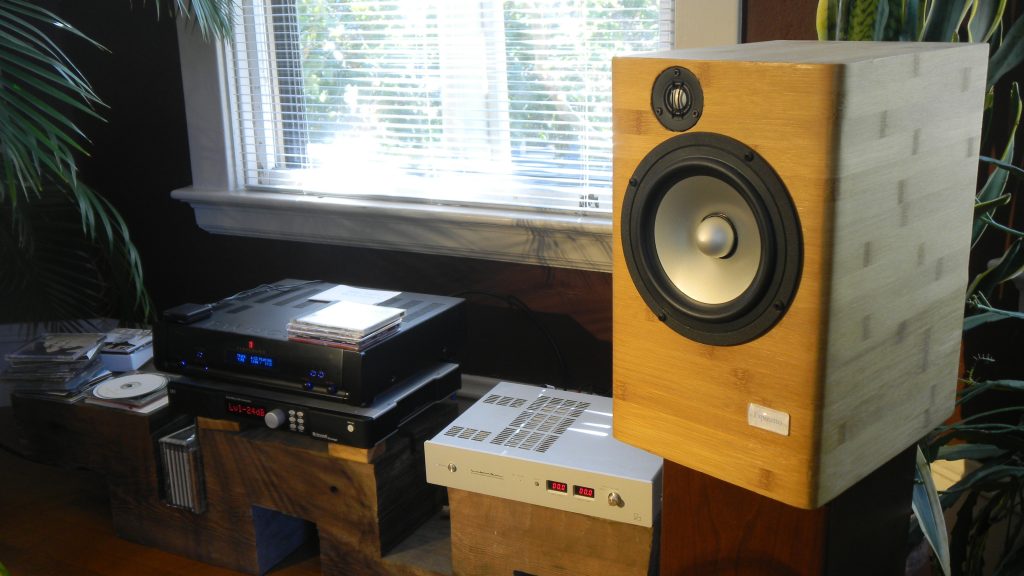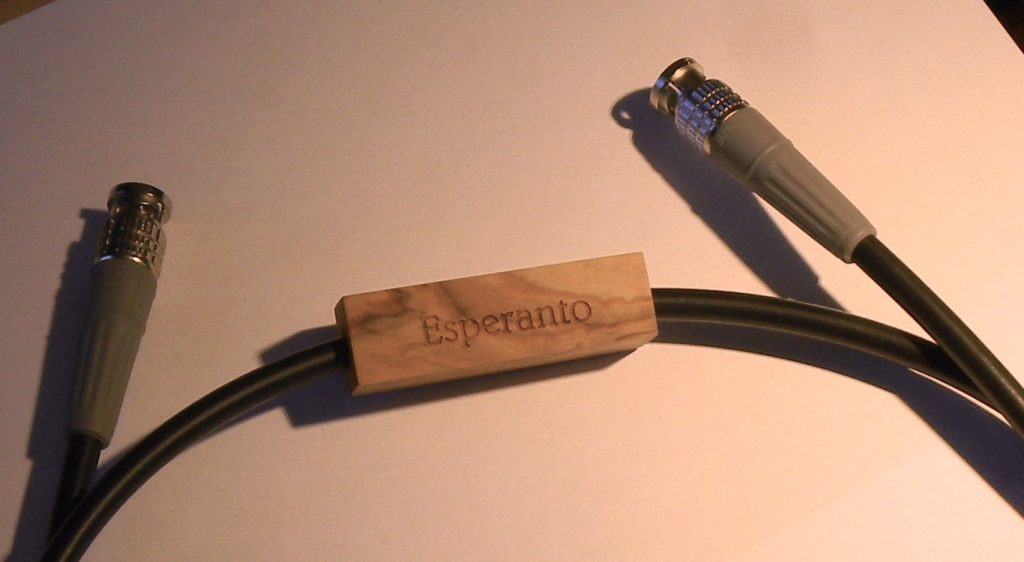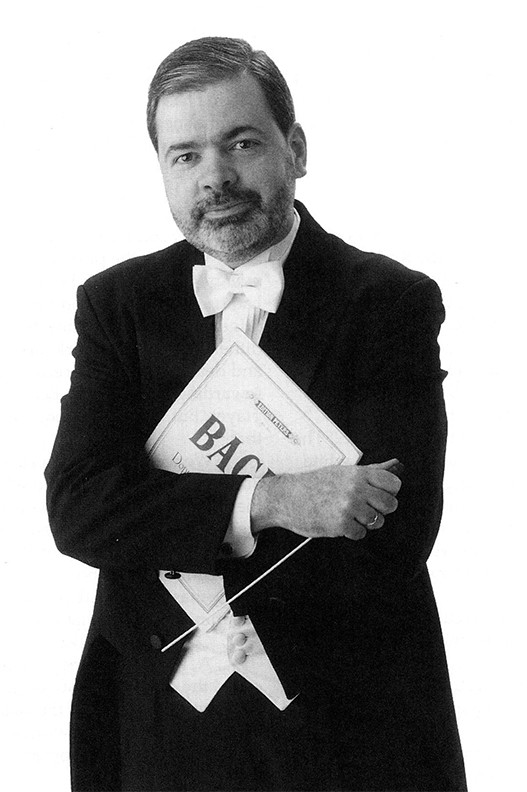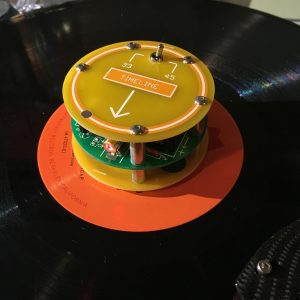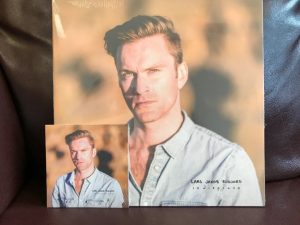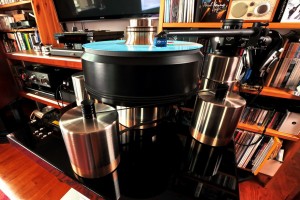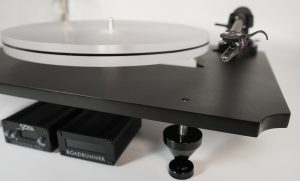This is a fascinating new series from our good friend John Marks, editor of The Tannhauser Gate. In it, John proposes to provide a reasonably simple and affordable method for converting LPs to digital files for playback on computer-based systems. I think that his comments will be quite helpful for those of our readers here at PF who would like to do this, but need some recommendations.
John's series should meet that need quite nicely.
Dr. David W. Robinson, Ye Olde Editor
Berlin the Bear staying on top of things in LP-Land. (Photo by John Marks)
Time for a new project!
Over the past few years, a new consumer-audio product category has emerged, that of phonorecord playback equipment with the added capability of outputting a digital datastream via USB connection. (I.e., a phono playback stage that also has analog-to-digital conversion and a USB digital output.) The ultimate expression of that concept is a turntable with onboard phono playback equalization and digitization. Such a turntable has both analog outputs for listening and a USB output for recording via a computer or other compatible digital device. Such a package has the advantages of low or low-ish cost, and easy setup. But its cost constraints will lead to sonic compromises, and such setups cannot accommodate pre-RIAA LP discs or 78 rpm records.
So I set myself on a quest to find a Pareto-Principle solution. This will be a four- or five-part series wherein I will discuss alternatives to USB turntables for people who want better performance, or who already have a non-USB turntable they are happy with. Along the way there will be some history lessons, and some practical advice too.
What "Pareto-Principle solution" means; some background on the challenges of storing music on analog physical media; and more, below.
Rega's new Planar 3 package may be the Pareto-Optimal solution. (Photo by John Marks)
Vilfredo Pareto (1848-1923) was an Italian economist with a vegetable garden. Pareto noticed that about 80% of the pea production in his garden came from about 20% of the peapods; and from that, both a Business Shibboleth and a Business Security Blanket were born. The usual form is, of course, "20% of your customers account for 80% of your sales." Applying this (hotly disputed in some quarters) concept to resource allocation in engineering, a Pareto-Principle solution delivers 80% of the performance of the most expensive solution at 20% of the cost.
Obviously, that is painting with a brush so broad that the paintbrush won't fit into a one-gallon can… especially in a world where there is an LP turntable with a US MSRP greater than the price of a Mercedes S-Class sedan (that means, over $100,000). So, for the purposes of sanity, when I write "Pareto-Principle solution" in this context, I am disregarding turntables that "normal people" are not likely to buy. My Impressionistic survey of turntables on offer suggested that the range between $6000 to $7500 was the watershed above which incremental improvements were likely overtaken by prices that increased far more rapidly. Applying the Pea Patch Rule, I then went looking for a turntable/arm/cartridge solution under $1500.
I will write separate posts about each of the components in this LP playback and archiving system. But before turning to that, a few words about the challenges of storing music on analog physical media.
In theory, (purely mechanical) sound recording could have been invented during the reign of Napoleon Bonaparte (1804-1814/15). There were megaphones and diaphragms and needles and wax and bearings and even clockworks. Except, nobody put all the pieces together properly. That said, some people got tantalizingly close… .
British physician Thomas Young made tracings of tuning-fork vibrations in 1807, and French printer Édouard-Léon Scott de Martinville in 1857 invented the "Phonautograph." But both were record-only devices that inscribed media that could be studied visually, but could not be played back acoustically. At least at that time….
1859 model of Édouard-Léon Scott de Martinville's phonautograph. (Wiki)
In 2008, however, scientists at Lawrence Berkeley National Laboratory in Berkeley, California used optical scanning and image-to-sound conversion software to create digital audio files of the earliest known recordings of human voice and speech, and they are truly awful. In large part because the phonautograph's barrel was hand-cranked.
Here's the inventor, slowly singing the French song "Au clair de la lune" in 1860:
A little-known aspect of early mechanical phonorecord recording (by which I mean before 1926) was that many recording studios were located on the upper floors of buildings because the recording lathes were powered by drop-weights, as in a cuckoo clock. Drop-weight mechanisms had steady speed and abundant torque. And such mechanisms were well-known long before Thomas Edison put all the pieces together.
I have heard acoustically-recorded 78 rpm records played back on high-quality acoustical-only phonographs, and the midrange impact can be startling. But acoustical recording systems are hampered by the conflict between the logarithmic (orders of magnitude) nature of sound waves of differing pitches and the physical limitations of the media.
Mechanical recordings aim to create an analog model of sound waves, but that project runs afoul of the fact that sounds of different pitches have different wavelengths. The highest note "A" (3520 Hz) on a full-size piano keyboard has a wavelength of 3.85 inches, whereas the lowest "A" (27.5 Hz) has a wavelength of 44.1 feet. Even Middle C (261.6 Hz) has a wavelength of 4.3 feet. That acoustical recording works as well as it does is rather amazing, and owes largely to the facts that the horn is too small to capture very low frequencies, and that the moving parts of the recording mechanism are massy and lossy.
The invention of the vacuum tube for amplifying electrical signals led to the development of electrical recording, which, starting circa 1926, quickly took over from the earlier acoustical system. However, in order to record properly, the music signal had to be cut in the bass frequencies (so that the needle of the playback machine would not jump the grooves), and boosted in the high frequencies (to overcome inertia in the cutting head and mechanical resistance in the medium being inscribed, either wax or shellac or later acetate). Playing back those equalized (or actually, distorted) frequencies properly is a major issue in playing back all phonorecords, but especially those from the time before the treble-pre-emphasis-and-bass-cut EQ curve became standardized as the RIAA curve. (The linked-to Wiki article is a very good introduction to that.)
In following weeks, I will focus on each component in turn.




